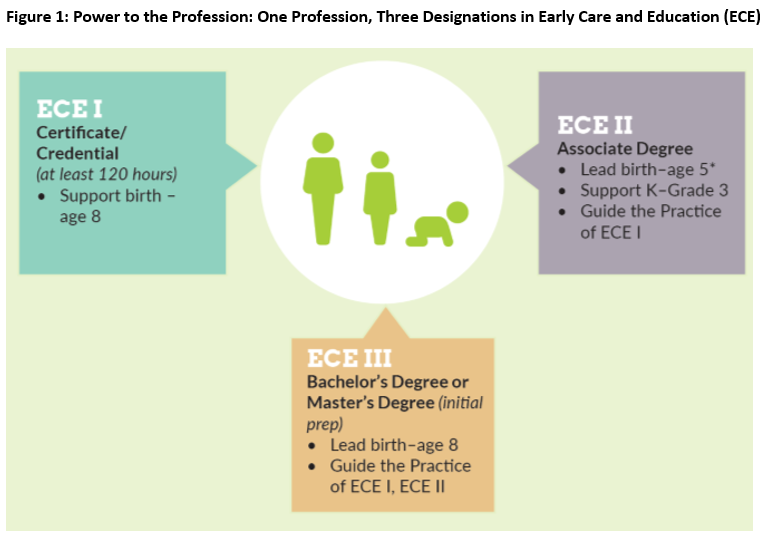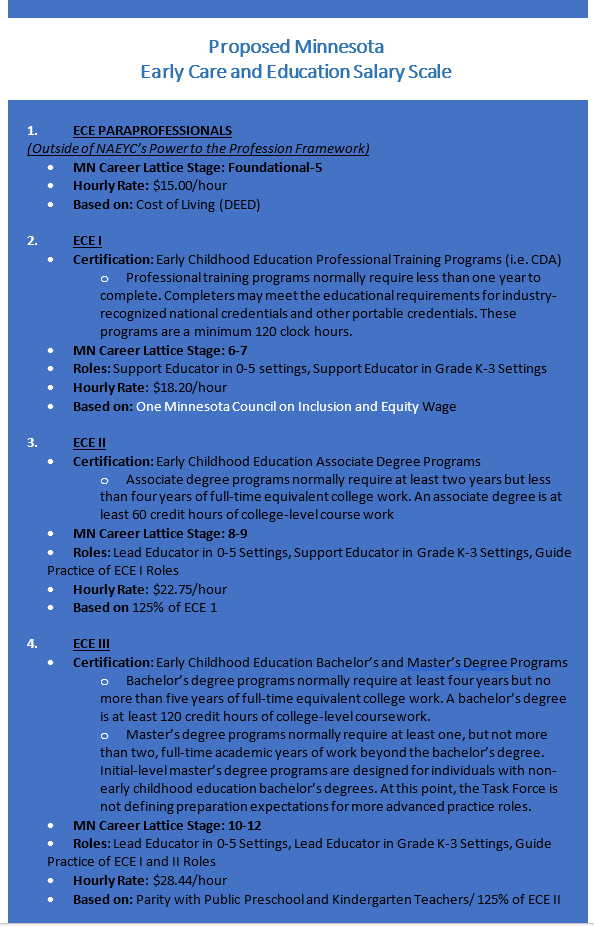

by Oriane Casale and Zina Noel
March 2021
The previous article in this series provided documentation on the very low wages in the early childhood profession, particularly in private ownership settings. The early care and education (ECE) workforce, including owners of family child care programs as well as Head Start, child care center and preschool teachers outside of the public school system, have median wages below any other occupation requiring the same level of education in Minnesota, and well below the cost of living1. Wages are so low that these occupations are not encouraged choices for workforce training in Minnesota based on U.S. Department of Labor guidance.
As a result of this low compensation, the industry suffers from recruitment and retention challenges that have made it impossible for many programs to meet long-standing staffing requirements that are a part of licensing regulations in Minnesota. State-issued variances have addressed programs' immediate needs to hire staff but have not been able to address longer term issues of training, workforce development and quality.
In the case of the early care and education workforce, wage equity will also enhance racial and ethnic equity in Minnesota. The industry is more diverse in its racial and ethnic composition than many other Minnesota industries. Overall, Black, Indigenous and People of Color (BIPOC) workers comprise 23% of the workforce compared to only 15% of the workforce across all Minnesota industries. Wage equity in this industry would help its entire workforce by creating more economic stability for their families and children as well as for their own professional development.
This article provides an analysis of an equitable wage scale in the industry that addresses issues of recruitment and retention and incentivizes human capital development within the profession. This article focuses on wage. However, in the longer run, the complete compensation package, including benefits such as health insurance, retirement benefits, paid time off and more should be considered.
The analysis that follows was developed by the Transforming Minnesota's Early Childhood Workforce Compensation Committee. Implementation of this wage scale is predicated on increased funding for the industry. In the absence of additional resources it is unlikely that the industry would be able to implement this wage scale without putting programs out of business and pricing most families out of the market. As the previous article documents, businesses operate on razor-thin margins and parents spend an unsustainably high share of their income, on average, for early care and education.
This article provides a proposed wage scale and rational for the scale. The wage scale proposed in this article should not be construed as an official policy proposal or position by DEED or the Walz-Flanagan Administration.
The Center for the Study of Child Care Employment, the nation's preeminent research organization dedicated to the early care and education workforce, along with other early childhood researchers and experts2, has identified the development and use of wage scales as a necessary strategy for improving compensation. More equitable wage scales could improve early childhood staff recruitment and retention, a key to program quality and relationship continuity critical to child development, as well as encourage early care and education professionals to invest in human capital development (e.g. education, training). Equitable compensation is a necessary piece of the puzzle but a work environment that supports early care and education professionals is also necessary to incentivize human capital development, retention and high quality teaching practices in this industry.
The following early care and education wage scale was built through analysis of Minnesota's existing early childhood workforce, the wage trajectory of careers with similar educational requirements, consultation with the TEACH Early Childhood® National Center, and analysis of early childhood salary scales from Illinois, Nebraska, Oregon, Rhode Island and Washington (see Table 1). This wage scale is intended as a recommendation that can be used to inform cost-estimate modeling for expanding access to high-quality early care and education programming, to advocate for state and local investments in early care and education markets, to provide a guide for fair and just compensation, and to strengthen the state's existing Quality Improvement and Assessment System (QRIS). These recommendations are for the entire state of Minnesota and do not address regional differences in cost of living.
Table 1: Nationwide Early Care and Education (ECE) Wage Scale Comparison
| Wage Rate | Minnesota | Illinois | Nebraska | Oregon | Rhode Island | Washington |
|---|---|---|---|---|---|---|
| Pay Levels | 4 | 4, + 10 positions | 4 | 3; Explicitly established for lead teachers | 6 | 15 |
| Minimum | $15.00 hourly | 91% of ECE I | Specific for each level and region | ECE I | $15.21 hourly $31,764 annual | |
| ECE 1 | $18.20 hourly | $15.00 hourly | 81% of ECE II | $24,087-$31,313 annual | $16.00 hourly $33,280 annual | $16.81 hourly $34,965 annual |
| ECE 2 | $22.75 hourly | $17.00 hourly | 75% of ECE III | $24,904-$40,948 annual | $19.00 hourly $39,520 annual | $20.36 hourly $42,349 annual |
| ECE 3 | $28.44 hourly | $24.00 hourly | 100% of kindergarten teachers | $33,721-$48,174 annual | $22 hourly $45,760 annual | $25.12 hourly $56,035 annual |
| ECE + | N/A | $53-57K | N/A | N/A | $24.15 hourly $50,240 annual | $27.72 hourly $57,660 annual |
| Annualized salary | 2,080 hours/year | 2,080 hours/year | Unclear | Unclear | 12 month | 2,080 hours/year |
| Parity? | Yes, at ECE + level, with licensed K-12 teachers | Yes, with licensed public school teachers (BA) | with Kindergarten teacher compensation | 100% with BA, 85% with AA, 65% with DA | ECE+ w/ kindergarten teacher (2017-18) | with Seattle School District certified instructional staff |
| Calculator | DEED Living Wage Calculator | Labor statistics + minimum wage law | NC Kindergarten wages, set annually | Average of lowest and highest wage regions | Living wage calculator, note about increases with inflation | based on existing Cost of Quality Phase 2 report |
| Regions? | Statewide | 2 (Downstate, Chicago Metro) | Statewide | Statewide, with regionally specific minimums | Statewide | Statewide |
| Compensation Benefits | No | No | Partial (*31.5% was added to salaries to cover benefits) | No (only applies to 4 & 5 star rated programs) | No | Yes |
| Professional Supports | No | No | No | No, but included in QRIS | No | No |
| Health Benefits | No | No | Yes* | No, but included in QRIS | No | Yes, plus access to life insurance |
| Retirement Funds | No | No | Yes* | No | No | Yes |
In accordance with the Power to the Profession model recently released by the National Association for the Education of Young Children (NAEYC), this wage scale includes three levels of ECE professionals: ECE I, II, and III (see Figure 1). These levels categorize ECE professionals by both their professional training and certification and their roles and responsibilities, with progressively greater educational requirements and professional responsibilities.
This structure creates a fairly paid, low-qualifications entry point into the profession (ECE 1). This addresses the current shortage of ECE professionals in Minnesota, while also incentivizing those who go into the field to increase their qualifications in order to earn a higher wage. Power to the Profession's levels are meant to guide categorization of all early childhood educators, regardless of setting, and, similarly, this wage scale is intended for both family child care and center-based early care and education settings. In addition, this wage scale does not differentiate based on the ages of the children served. While currently infant and toddler teachers earn less than that earned by educators serving three- and four-year-olds, there is no scientific reason to justify this disparity. In fact, from what we know from the research about child development, those earliest years are critical years of brain formation and development, which provide the foundation for all future learning, social emotional development and health3.

ECE paraprofessionals without the qualifications for ECE 1, Child Development Associate certification, would start at $15.004, the current basic cost of living wage for a single person based on Minnesota's statutorily mandated Cost of Living analysis. This is also the lower threshold wage goal set by the One Minnesota Council on Inclusion and Equity. Ideally these paraprofessionals include those in informal settings and members of the existing workforce who do not currently have an early childhood education credential. While they are not considered ECE professionals in NAEYC's Power to the Profession, they play an important role in the workforce, especially during a time of labor force shortages. Further, this improved wage ($3-4 dollars higher than the current statewide average pay rate) may incentivize these educators to stay in the field longer, thus reducing turnover, and increase their qualifications, which may lead some to obtain the certifications for ECE I.
The wage rate for ECE I is set to match the family living wage ($18.20) set by the One Minnesota Council on Inclusion and Equity, which is the cost of living for a family of three with one adult working full time, one adult working part time and one child based on the Cost of Living analysis. This is the most typical family structure in Minnesota. The wage for ECE II is then set at 1.25% of the ECE I rate ($22.75), and ECE III is set at 1.25% of that rate ($28.44). The current average wage for ECE professionals is substantially lower than this wage scale as the previous article in this Minnesota Economic Trends series documents.
In order to create a wage scale that incentivizes and provides the resources necessary for human resource investment, this wage scale uses a 1.25 percentage increase between levels, representing the lower end of wage percentage increases in the compared fields (see Table 2). This creates wage parity between public school ECE professionals (prekindergarten and kindergarten teachers) and the rest of the early care and education workforce, ensuring that ECE professional with bachelor's degrees or beyond are able to earn comparable wages to their public school counterparts. Parallel to this, statutory language in Minnesota calls for paying prekindergarten instructional staff in voluntary prekindergarten programs wages comparable to those of local kindergarten through grade 12 instructional staff.
Table 2: Minnesota ECE Professional Wage Scales - Proposed
| ECE Level | Educational Requirement | Role | Hourly Wage | Annual Wage |
|---|---|---|---|---|
| Base level | High School Diploma | Entry level | $15.00 | $31,200 |
| ECE I | CDA Certificate | Support | $18.20 | $37,856 |
| ECE II | Early Childhood-related Associate Degree | Lead in birth - age 5 settings; Guide practice of ECE I | $22.75 | $47,320 |
| ECE III | Early Childhood Ed BA | Lead birth - age 8 settings; Guide practice of ECE I & II | $28.44 | $59,072 |
| *CDA - Childhood Development Associate certificate | ||||
Table 3: Comparable Fields in Minnesota
| Occupation/Education Required/Pay Increase for Additional Education | 25th Percentile | 75th Percentile |
|---|---|---|
| Administrative Workers (SOC 43) | ||
| High School/GED | $31,420 | $39,131 |
|
$28,890 | $37,244 |
|
$33,951 | $41,019 |
| Associate Degree | $39,680 | $52,926 |
|
$47,170 | $55,984 |
|
$32,190 | $49,869 |
| Bachelor's Degree | $74,401 | $93,332 |
|
$74,401 | $93,332 |
| Pay Increase | ||
| High School > Associate Degree pay increase | 26% | 35% |
| Associate Degree > Bachelor's Degree pay increase | 76% | 87% |
| Engineering (SOC 17) | ||
| High School/GED | $45,440 | $55,725 |
|
$45,440 | $55,725 |
| Associate Degree | $49,782 | $62,482 |
|
$54,637 | $67,714 |
|
$54,485 | $63,742 |
|
$44,747 | $60,561 |
|
$45,261 | $57,911 |
| Bachelor's Degree | $66,674 | $84,427 |
|
$51,939 | $66,836 |
|
$69,612 | $90,295 |
|
$69,016 | $83,544 |
|
$76,131 | $97,036 |
| Pay Increase | ||
| High School > Associate Degree pay increase | 9% | 12% |
| Associate Degree > Bachelor's Degree pay increase | 34% | 35% |
| Health Care (SOC 31 and 29) | ||
| Vocational | ||
|
$29,924 | $34,418 |
|
$42,824 | $47,706 |
| Associate Degree | $67,667 | $69,422 |
|
$67,667 | $69,422 |
| Master's Degree | $120,486 | $138,489 |
|
$164,976 | 187,538 |
|
$92,080 | $110,372 |
|
$104,404 | $117,558 |
| Pay Increase | ||
| Vocational > Associate Degree pay increase | 69% | 86% |
| Associate Degree > Master's Degree pay increase | 78% | 99% |
| Law Enforcement (SOC 33) | ||
| High School/GED | $36,715 | $45,650 |
|
$27,244 | $33,044 |
|
$38,249 | $51,697 |
|
$44,652 | $52,210 |
| Associate Degree | $58,614 | $72,474 |
|
$58,614 | $72,474 |
| Bachelor's Degree | $70,109 | $85,461 |
|
$60,817 | $75,111 |
|
$79,402 | $95,812 |
| Pay Increase | ||
| High School > Associate Degree | 59% | 60% |
| Associate Degree > Bachelor's Degree | 18% | 20% |
| Percentage Increase Between Levels | ||
| Level 1 > 2 | 26% | 48% |
| SOC 43: High School > Associate Degree | 26% | 35% |
| SOC 17: High School > Associate Degree | 9% | 12% |
| SOC 31 and 29: Vocational > Associate Degree | 69% | 86% |
| SOC 33: High School > Associate Degree | 59% | 60% |
| Level 2 > 3 | 51% | 60% |
| SOC 43: Associate Degree > Bachelor's Degree | 76% | 87% |
| SOC 17: Associate Degree > Bachelor's Degree | 34% | 35% |
| SOC 29: Associate Degree > Master's Degree | 78% | 99% |
| SOC 33: Associate Degree > Bachelor's Degree | 18% | 20% |
The goal of achieving wage parity at the ECE III level highlights several challenges. The first relates to the difficulty of finding a comparison wage for public-school preschool and kindergarten teachers in the state and excluding the cost of compensation benefits (i.e. health care, paid time off) from that salary. Given that K-12 salaries are set at the district level, there is a wide-range of salaries and accompanying benefits and therefore the wage may be significantly higher or lower than preschool and kindergarten teachers, depending on the district.
Additionally, ECE receive yearly salaries, as opposed to public schools where salaries are based on a nine or ten month work assignment. Furthermore, because ECE programs are often open on days when public schools are closed (e.g. spring break, teacher's conferences), there is an even greater difference in annual hours worked; in 2018, full-day kindergarten in Minnesota is required to have a minimum of 850 instructional hours and grades 1-6 have a minimum of 1,020 instructional hours. In comparison, an ECE professional working 40 hours per week at a year-round program will provide closer to 2,080 instructional hours.
As a starting point, the comparison wage for the ECE III level is set at the wage average for K-3 teachers in Minnesota, excluding special education teachers, which is $59,150 per year or $28.44 per hour. It should be noted that this does not account for the difference in annual hours worked nor does it include the compensation benefits most public-school educators receive as part of their salary.
Nonwage benefits are clearly an important part of the compensation package and have been shown to improve recruitment and retention of qualified early childhood educators making them another important strategy for reducing the current shortage in early childhood educators. However, they are out of the scope of this analysis at this time. The Center for the Study of Child Care Employment, together with the American Federation of Teachers, recently updated their model work standards for early childhood professionals and provides helpful guidance for future analysis that could encompass benefits, employment policies and practices, professional development and teaching supports – all core components of a professional work environment5.
Wage scales have been identified as a necessary strategy for improving compensation in the early care and education industry. The wage scale discussed here addresses compensation in an industry that routinely pays below the basic cost of living. It also addresses parity with similarly skilled occupations as well as parity with public school wages. Moreover, it builds in an incentive structure for human capital development. As a result, implementation of this wage scale statewide would help to build the early care and education workforce pipeline by increasing credentials within the workforce and reducing issues around recruitment and retention. However, additional resources for the industry are a necessary first step to make this happen without placing unsustainable financial burden on the families of young children and the programs that serve them.

1Employees of center-based programs generally receive a salary or wages while owners of family child care are operating their own small businesses, and as such, don't technically receive a salary or wages but rather have a "draw" or business profit. The term wage is used here to refer to both. A First Children's Finance survey found that family child care providers made just $8 an hour on average in 2016.
2These organizations include the Alliance for Early Success and TEACH Early Childhood National Center.
3A Science-Based Framework for Early Childhood Policy, Center on the Developing Child, Harvard University.
4Based on 2020 Minnesota Cost of Living, statewide, family size of one adult no children.
5The Model Work Standards, Center for the Study of Child Care Employment, UC Berkley.